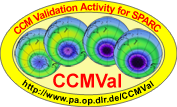Project

Chemistry-Climate Model Validation Activity 2 (CCMVal-2)
Abstract
SPARC has established the Chemistry-Climate Model Validation Activity (CCMVal) for coupled chemistry-climate models (CCMs). The goal of CCMVal is to improve understanding of Chemistry-Climate Models (CCMs) and their underlying GCMs (General Circulation Models) through process-oriented evaluation, along with discussion and coordinated analysis of science results.
Details
| Keywords: | CCMVal, climate, model, CCM's, GCM's |
|---|---|
| Previously used record identifiers: |
http://badc.nerc.ac.uk/view/badc.nerc.ac.uk__ATOM__ACTIVITY_dad6236c-8b45-11e2-a93a-00163e251233
|
More Information (under review)
The goal of the new activity is to improve understanding of CCMs and their underlying GCMs (General Circulation Models) through process-oriented validation. One outcome of this effort is expected to be improvements in how well CCMs represent physical, chemical, and dynamical processes. In addition, this effort will focus on understanding the ability of CCMs to reproduce past trends and variability and providing predictions from ensembles of long model runs. Achieving these goals will involve comparing CCM constituent distributions with (robust) relationships between constituent variables as found in observations. This effort is both a model-model and modeldata comparison exercise.At the Grainau workshop, a set of key diagnostics was defined for evaluating CCM performance with respect to radiation, dynamics, transport, and stratospheric chemistry and microphysics (http://www.pa.op.dlr.de/CCMVal/). This approach allows modellers to decide (based on their own priorities and resources) which diagnostics to examine in any particular area. The CCMVal activity will help coordinate and organize CCM model efforts around the world. In this way,the CCM community can provide the maximum amount of useful scientific information for WMO/UNEP and IPCC assessments.
As a first step, the CCM community has defined two reference simulations and a set of model forcings to support the upcoming WMO/UNEP Scientific Assessment of Ozone Depletion. The forcings are defined by natural and anthropogenic emissions based on existing scenarios, on atmospheric observations, and on the Kyoto and Montreal Protocols and Amendments.
